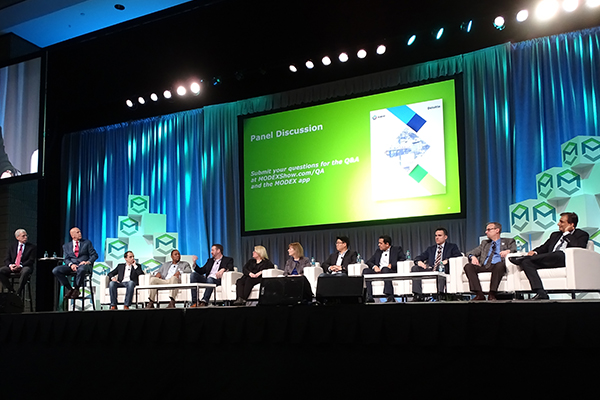A panel of supply chain leaders and technology experts discussed the findings of the newly released 2018 MHI Annual Industry Report, citing 11 key technologies that are driving next generation supply chains, while also naming top barriers such as cyber-security and framing the business case for the technologies.
This is the fifth in a series of industry reports that MHI has developed in collaboration with Deloitte Consulting LLP. Titled “Overcoming Barriers to NextGen Supply Chain Adoption,” the study is based on a survey of more than 1100 supply chain professionals. The keynote panel was moderated by Scott Sopher, principal with Deloitte Consulting’s Supply Chain practice, and George W. Prest, CEO of MHI.
Eleven technologies including robotics, predictive analytics, artificial intelligence, Blockchain and Internet are working together to create next-generation supply chains, Sopher noted. While some have made greater adoption inroads and some lead as potential disruptors or sources of opportunity in the view of survey respondents, it’s not one single technology that will constitute NextGen capabilities, said Sopher.
“It is clear that technology is a driver of [NextGen] change but it’s not a single technology. It’s really a combination and collaboration of these 11 highlighted in the survey,” Sopher said.
Cloud computing leads in adoption, the 2018 study found, with a 57% adoption rate which is expected to reach 91% in five years. The 2018 report includes two new technologies (AI and Blockchain) that are rapidly emerging.
The top three barriers to adoption the study found are making the business case, the supply chain skills gap, and building trust and security in digital, always on supply chains. When it comes to gaining value from technologies like predictive analytics, panelist Randy Bradley, assistant professor of Information Systems and Supply Chain Management, University of Tennessee, pointed out that obtaining the predictive capability is not itself the value driver.
“[The technology] cannot be the end goal,” said Bradley. “Many of those that are going to achieve value from predictive analytics see it as transient process to what we refer to as prescriptive analytics [where] now not only do we know what the issue is, but we understand why it’s occurring and we understand what actions we need to take.”
Panelist Kevin Condon, director of Engineering & Network Strategy, Kroger, said that while robotics has improved in many ways, competitors are often implementing very similar new technology, so it’s how you support the new tech with people skills and surrounding processes that will make the difference. “It’s not just about buying the robots; it’s about what you surround it with,” said Condon.
Visit MHI’s website to find a download of the full 2018 industry report.
Image Caption
- The keynote panel included (from left), moderators:
- Scott Sopher of Deloitte Consulting
- George Prest of MHI;
- Luca Bertuccelli, CTO, Sensitech;
- Randy Bradley, assistant professor of Information Systems and Supply Chain Management, University of Tennessee;
- Kevin Condon, Director Engineering; Network Strategy, Kroger;
- Annette Danek-Akey, SVP in Supply Chain, Penguin Random House;
- Barbara Ivanov, Chief Operating Officer and Director, University of Washington Urban Freight Lab;
- Jay Kim, Chief Strategy Officer, Upskill;
- Khwaja Shaik, IBM Thought Leader, IBM Academy of Technology;
- Michael Tidwell, Infrastructure Engineer, Tierion;
- Kevin Vliet, VP Supply Chain Engineering, Automation and Design, Target;
- Nick Vyas, assistant professor of Clinical Data Sciences and Operations, University of Southern California.
Article topics








